Less water doesn’t mean a boring garden. Here are 5 tips for a beautiful, dry climate garden that saves water.

Less water doesn’t mean a boring garden. Here are 5 tips for a beautiful, dry climate garden that saves water.

Last weekend, my husband and I went away to celebrate our 30th wedding anniversary. We’d been looking forward to leaving kids and work behind and spending time alone eating great food, sleeping in and long walks enjoying beautiful surroundings.
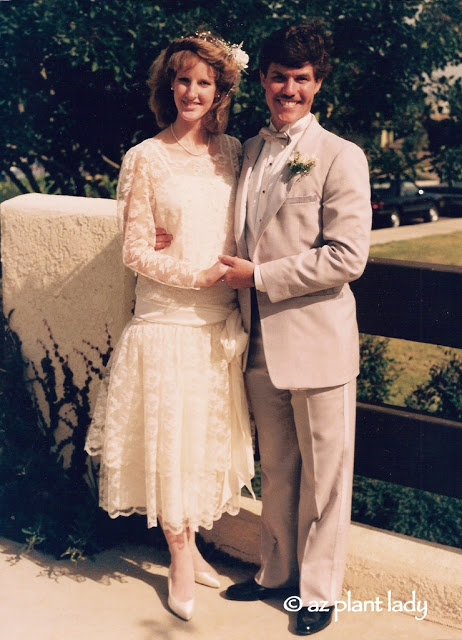
30 years ago
Now with past anniversary milestones, my husband would give me a piece of jewelry, and you would think that being married for 30 years would be marked by maybe a ring or necklace, but I wanted something else for this milestone anniversary.
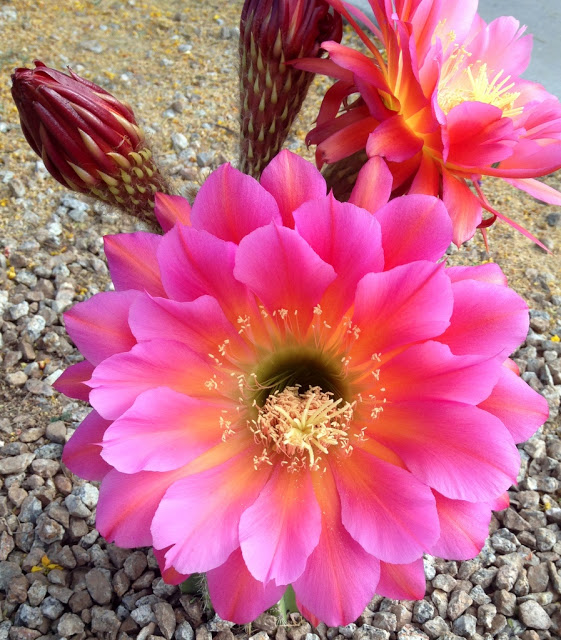
Last month, one of my blog followers sent me a photograph of his stunning torch cactus (Trichocereus/Echinopsis hybrid), ‘Flying Saucer’. Ever since I saw the brightly-colored flowers of this cactus, I knew that I wanted one for my garden.

Since our anniversary trip was to take us through the city of Tucson, we planned a short diversion to B&B Cactus Farm.
As we pulled up to the nursery, I was hoping that they had a ‘Flying Saucer’ torch cactus just for me.
These cacti are native to South America and do very well in the desert Southwest. Their large blooms come in many different colors and often repeat throughout late spring and summer.
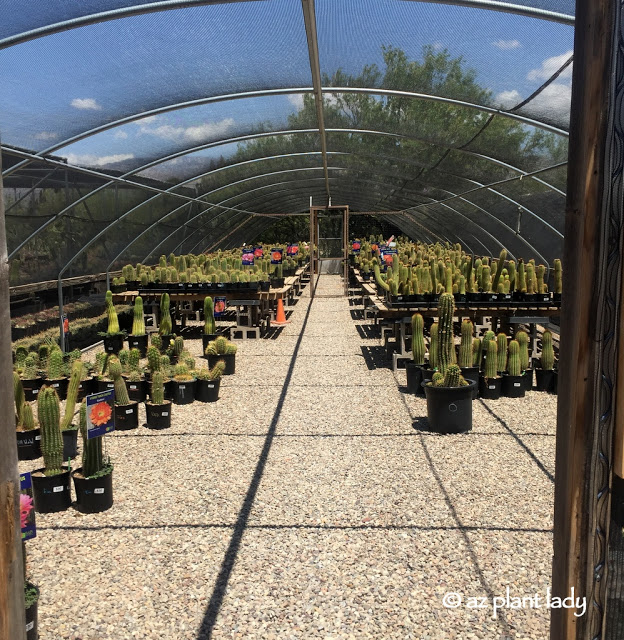
Walking through the cactus nursery, there was a large number of agave, cacti, and other succulents, which were somewhat distracting me from my mission to find the section where the torch cacti were located.
Finally, I found them!
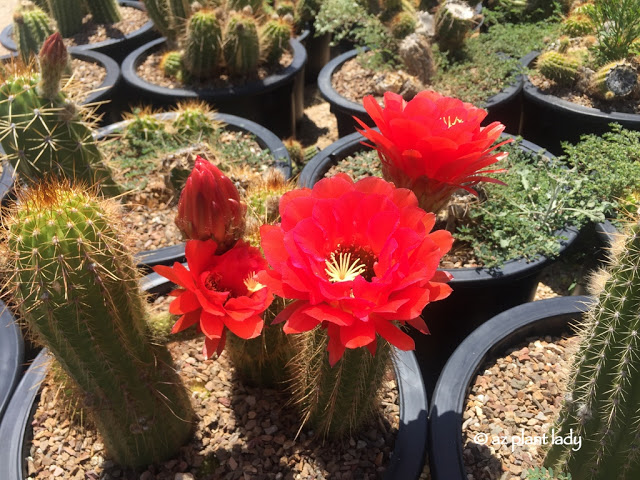
Some were in full bloom like this ‘Blood’ variety.
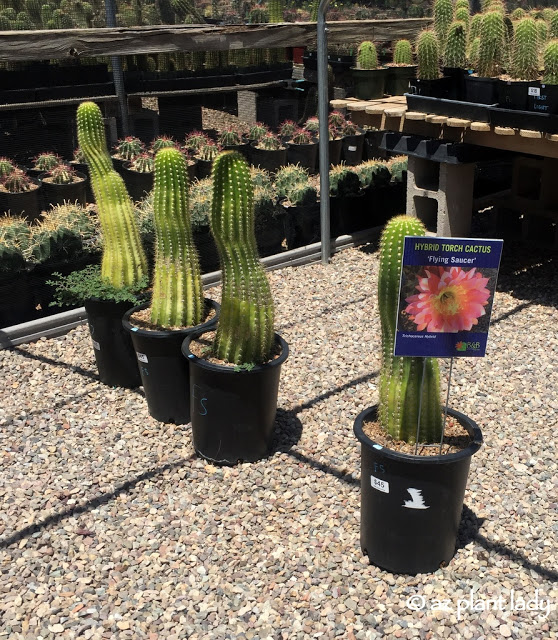
Toward the entrance, they had the larger specimens including a few large ‘Flying Saucer’.
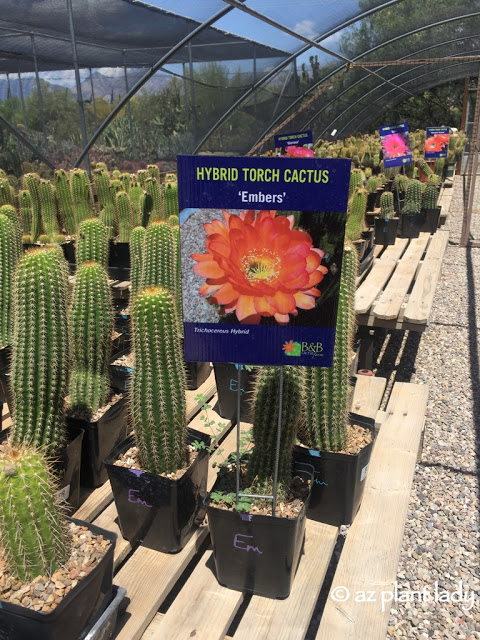
There were also some other hybrids as well.
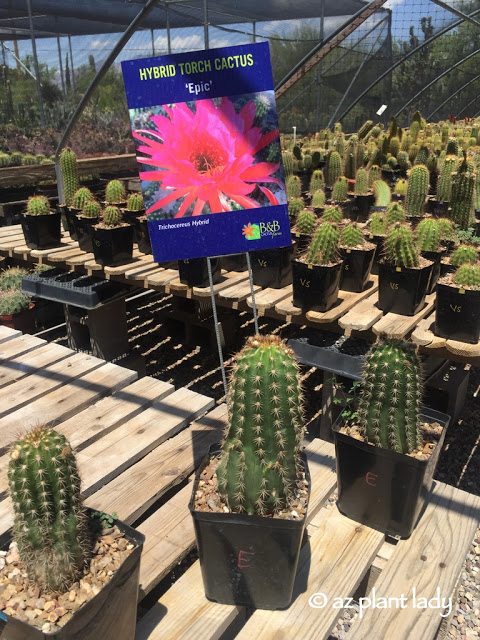
It hard to believe that even the younger torch cacti could produce large, colorful flowers.
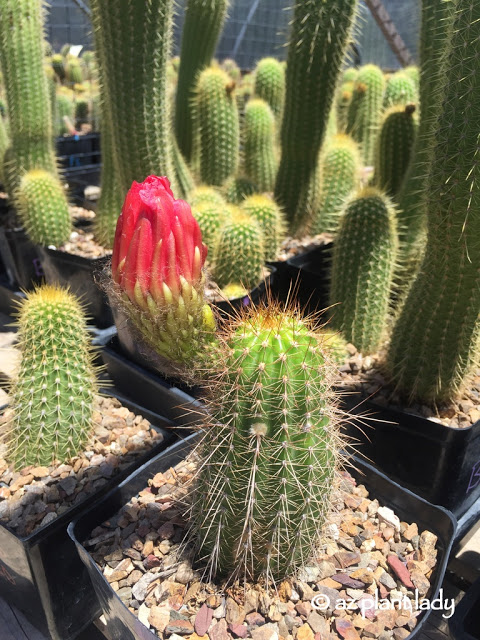
The blooms last only a couple of days, but there are often multiple blooms.
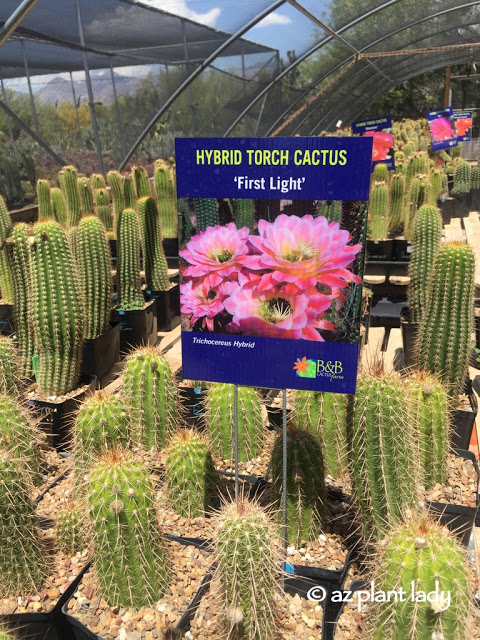
At this point, I should mention that while I appreciate many different types of cacti and use many in my designs, I only have a few in my landscape.
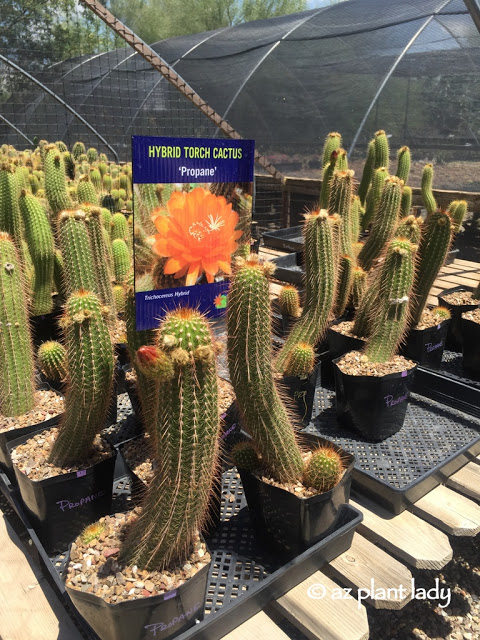
But, because I love flowers, I wanted to make room for one of these lovely cacti.
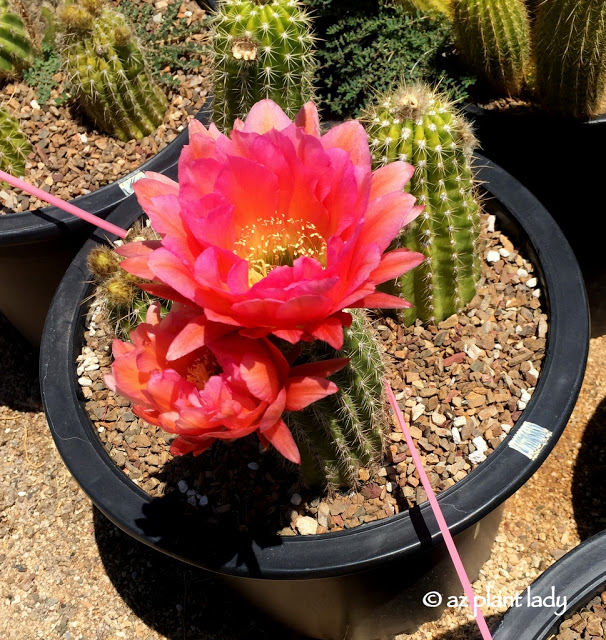
It is hard to believe how these cacti, that blend into the background throughout most of the year, are completely transformed by these breathtaking blossoms.
Now, back to my decision. As you might have expected, I was tempted by the other varieties of torch cactus. While they did have the ‘Flying Saucer’ one that I wanted, they only had a few large specimens. So my choice was to buy one large one or two smaller torch cacti for less money.
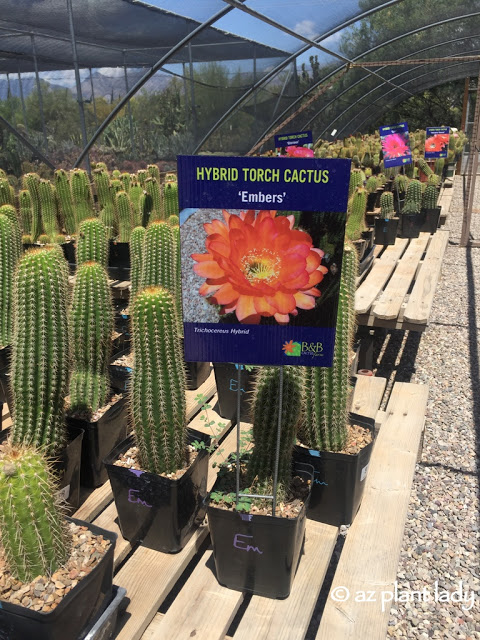
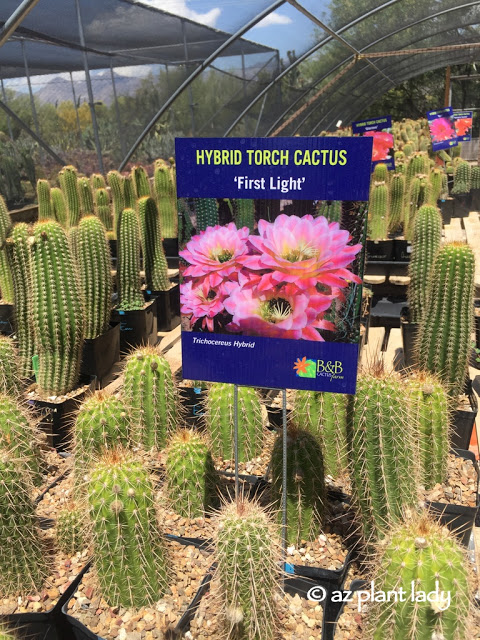
I elected to buy a smaller ‘Ember’, which looked similar to the ‘Flying Saucer’ and I picked the ‘First Light’ since I love pink flowers.
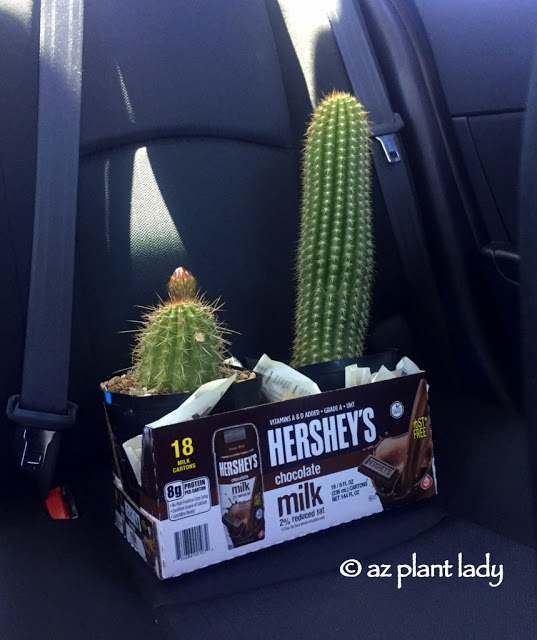
As we drove away, I looked back at my new torch cactus in the back seat thinking that I couldn’t wait to plant them when we got home. My husband smiled and said, “You never cease to surprise me, choosing cactus to mark our 30th anniversary rather than jewelry”.
We had a wonderful weekend together, and my torch cacti will be planted this week. I’ll be sure to show you pictures of their blossoms. Have you ever seen a torch cactus or perhaps, have one yourself?
For more information on these cacti and their beautiful flowers, click here.

Freezing temperatures are coming tonight and forecast to last for the next several days.
Take a drive down the street in your neighborhood, you will probably see landscape plants covered with assorted sheets, towels or frost cloth.

Those that don’t protect their frost-sensitive plants such as lantana, bougainvillea, yellow bells, orange jubilee or hibiscus will soon have plants that look like this…
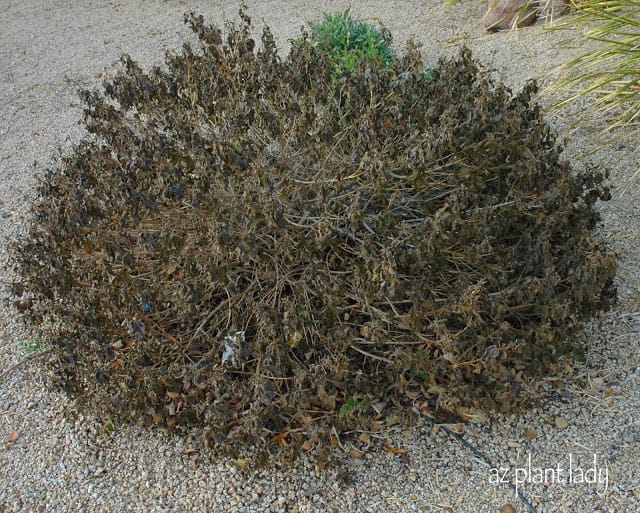
In most cases, you do not have to cover your frost-sensitive plants when temps dip into the lower 30’s.
There is nothing wrong with allowing the top growth of your ornamental plants to get frost damage. You just prune it away in spring.
For those of you who don’t like the look of frost-damage, then you will need to protect your plants from the cold.
**If temperatures are predicted to dip into the 20’s – then I do recommend protecting them from frost because temps this cold can kill a plant.
I wrote a blog post earlier this year when temps hit the low 20’s. It talks about how to protect plants from frost (and how NOT to) along with the types of plants to protect.
You can read it here…
*******************
I hope you are having a great week. I must confess to being a little behind on writing blog posts this month with all the Christmas goings on 🙂

I don’t know about you, but I have enjoyed the wet weather of the past few days. We almost received 3 inches of rain where I live in a period of 48 hours. For those of you who do not live in the desert – that is considered A LOT of rain for us 😉
I spent Saturday morning dodging raindrops as I visited two different clients regarding their landscapes. The rest of the day, I spent indoors just thinking of how much my garden is enjoying this rain.
You may not realize that rain water is much better for your plants then the water that comes from your hose or drip emitters. Our water is somewhat ‘salty’, which is a result of its journey down the Colorado river and all the rock it passes by.
Plants do not like salt much and a heavy rain will help flush the salts away from the soil.
As the sun began to peek through the clouds this afternoon, I ventured out into the garden in order to harvest some lettuce and Swiss chard for our dinner.

A small sampling of today’s harvest.
It had been a while since I had taken a good look at my vegetable gardens and there was quite a bit more to harvest then I had expected.

I am rapidly falling in love with Swiss chard (yes, I said ‘love’).
While I do not like cooked leafy greens, I have been surprised at how delicious raw Swiss chard is in salads.
It also adds a nice bit of color with its red and yellow veins.

Sugar snap peas are covering their vines, but it is hard to find them all since they blend in so well with the leaves.
I plan on serving them on our veggie tray Thanksgiving morning.
Right now, I have more radishes then I know what to do with. But, we had 5, thinly sliced radishes in our salad. In addition to thinly slicing them, I also quarter them so that my kids will eat them.

Two of my favorite types of leaf lettuce – Romaine and Black-Seeded Simpson.
I have had some problems with caterpillars eating my lettuce, so I will head out tomorrow with my spray bottle of BT (Bacillus thuringiensis).

Fall is the best time of year for all of my pepper plants. While they can handle hot temperatures, they don’t flower during the height of summer.
Once it begins to cool down in mid September, flowers appear again followed by peppers.
Sadly, once the first frost occurs, they will stop producing and will often die. Last year, I was able to save my bell pepper plant by covering it when temps dipped below freezing.
I have a ton of bell peppers and jalapeños. I will dice them up and place them in freezer bags so that I can enjoy them throughout the winter months.

harvesting vegetables
I discovered that I had a lot of parsley growing and I only harvested about half of it.
While parsley will last through the winter months, my basil won’t survive the first frost. So, I picked some basil too.

harvesting vegetables
I plant to dry my basil and parsley. Once dry, I will crush the leaves and put them into spice jars.
Drying herbs is easy and you can learn how to do it here.
The remainder of the fresh parsley that I have growing outdoors I will harvest on Thanksgiving to use as a garnish for a few of my favorite dishes.
While I spent part of this afternoon harvesting vegetables, I noticed that I still have not thinned out my carrot seedlings. Oh, they will still grow if I don’t thin them, but what I will get in return are small carrots not worth eating.
So, I’ll grab a pair of scissors and head out into the garden and snip off the extra.
*************************
How about you?
Have you put your garden to bed for the winter or do you still have things growing in it?
I’d love to hear what is happening in your garden…

Yesterday, I showed you a photo of a citrus tree that I came upon during a landscape consultation.
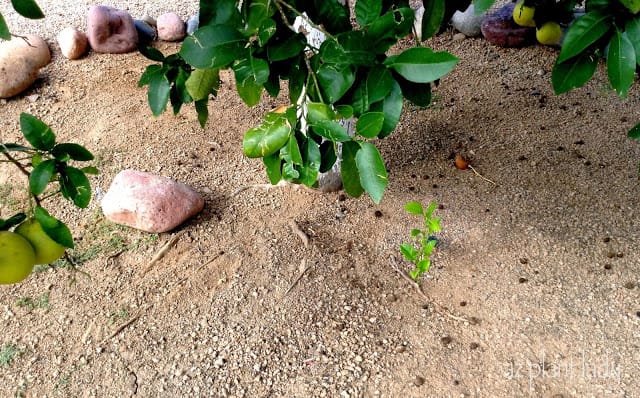
I mentioned that there was more then one problem affecting this tree. There are actually two large problems and one small problem.
Problem #1: Look at the area near the trunk. Notice a little green shoot coming up from a small citrus root?
This innocent-looking little sucker can cause a lot of problems if allowed to grow. The reason for this is that citrus trees are grafted onto a vigorous rootstock.
Basically, the top of a citrus tree and the roots come from different plants. Citrus trees we enjoy in our landscape don’t have a particularly strong root system. So, they are grafted onto a thorny, citrus tree that has vigorous roots and sour fruit.

Occasionally, small suckers from the thorny, citrus tree start to grow up from the roots or the base of the trunk below the bud union. The bud union is a bulge around the lower part of the tree, about a foot above the ground. Any suckers that originate from below the bud union should be removed, because if allowed to grow – the thorny citrus tree will grow and take over.
Now, back to our original picture for our second problem…
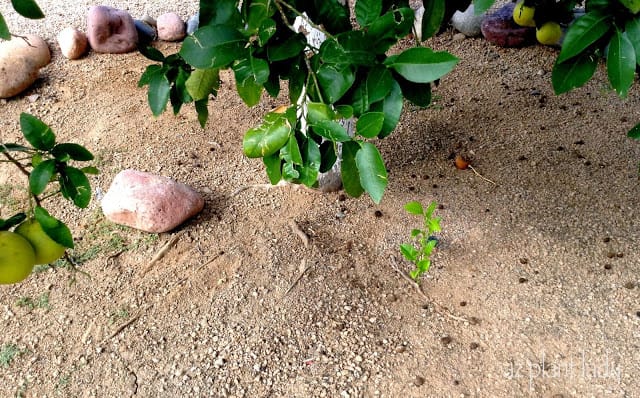
Problem #2: Look closely at the soil and you can see signs of shallow irrigation. How can you tell? Look at the small citrus roots criss crossing out from the tree. In a properly watered citrus tree, you shouldn’t see the roots at all.
This indicates that when the tree is irrigated, that the water is not turned on long enough to penetrate to the recommended 3 ft. depth.
When I pointed this out to the homeowner, she indicated that if the water is turned for too long, that it runs out from the basin.
There are two solutions for this problem.
– Elevate the sides of the basin to at least 6 inches high and allow to fill with water. Next, check to see how deeply you have watered by taking a long, narrow stick or piece of rebar and push it into the wet soil. It should go down fairly easily to the point where the water permeates. Pull it back out and you will get a good idea of how much more or less water you will need.
– If after trying the first solution and you still haven’t hit the recommended 3 ft. depth, then try this trick – water in the morning, filling up the basin. Allow the water to sink and fill the basin again later in the day. This should help you achieve the right depth.
The smaller problem is really nothing to be overly concerned about…
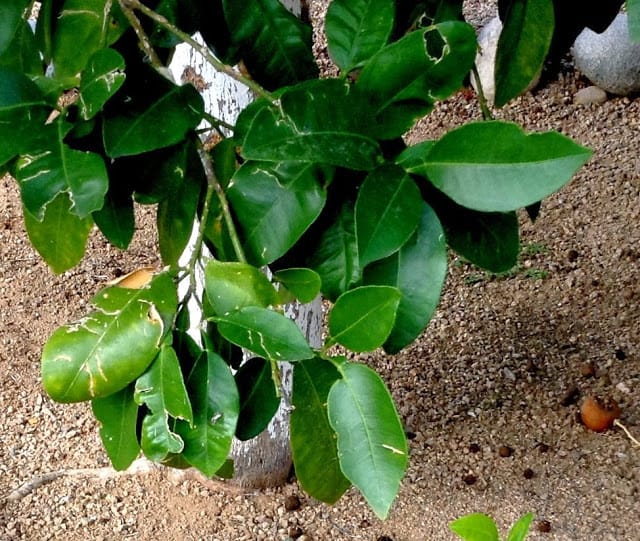
If you look closely, some of the leaves have ragged edges and holes. The damage is caused by the Orange Dog Caterpillar. This caterpillar appears in the summer months and resemble ‘bird poop’ which makes them hard to spot.
These caterpillars will turn into the beautiful Giant Swallowtail butterfly. Mature citrus trees can usually handle the damage from the caterpillars, so in most cases, the best thing to do is nothing.
For additional resources for raising citrus in the Valley of the Sun and other areas throughout the Southwest, check out this helpful link.
Do you have citrus trees in your landscape? Which kinds?

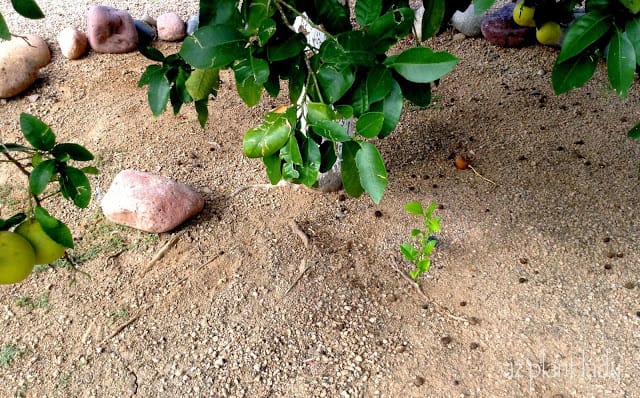
something wrong with citrus tree
Last week, I came upon this citrus tree while I was doing a consultation.
At first, there was one problem that I noticed right away. As I peered closer, I saw that there was another problem affecting this tree.
The tree was well-fertilized and I could see no sign of nutrient deficiencies.
Can you tell what is wrong with this tree?
Leave your guesses below in the comment section and I will reveal the answer tomorrow 🙂
*You may be wondering why you should care about the problems of this particular citrus tree. Well, if you have citrus growing in your garden, you may have the same problem(s) and not even know it.
My hope is to help others identify and correct problems with their plants that they may not be aware of until it is too late.

I promise not to sell or share your email with anyone ever!
*Please note that I cannot answer individual gardening questions.
*As an Amazon Associate I earn from qualifying purchases.
| Cookie | Duration | Description |
|---|---|---|
| cookielawinfo-checkbox-analytics | 11 months | This cookie is set by GDPR Cookie Consent plugin. The cookie is used to store the user consent for the cookies in the category "Analytics". |
| cookielawinfo-checkbox-functional | 11 months | The cookie is set by GDPR cookie consent to record the user consent for the cookies in the category "Functional". |
| cookielawinfo-checkbox-necessary | 11 months | This cookie is set by GDPR Cookie Consent plugin. The cookies is used to store the user consent for the cookies in the category "Necessary". |
| cookielawinfo-checkbox-others | 11 months | This cookie is set by GDPR Cookie Consent plugin. The cookie is used to store the user consent for the cookies in the category "Other. |
| cookielawinfo-checkbox-performance | 11 months | This cookie is set by GDPR Cookie Consent plugin. The cookie is used to store the user consent for the cookies in the category "Performance". |
| viewed_cookie_policy | 11 months | The cookie is set by the GDPR Cookie Consent plugin and is used to store whether or not user has consented to the use of cookies. It does not store any personal data. |
